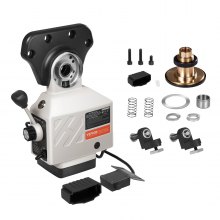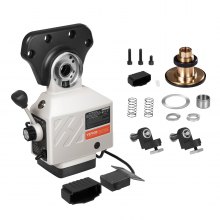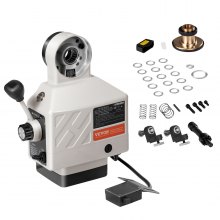VEVOR Power Feeders: The Milling Precision Solution for Best Results
A power feed is a tool used in milling machines that automatically feed material through the cutter at a constant speed, making the milling process easier.
The pinnacle of dependability, VEVOR Power Feeders are made to work perfectly with your equipment, guaranteeing that each cut, curve, and stroke produces the best possible results every time.
How Does a Power Feeder for a Milling Machine Work?
The power feeder is fixed to the milling head or machine table. Its placement enables it to interact with the component and deliver the required feed rate.
The operator uses a variety of parameters and tweaks to manage the power feeder. Depending on the feeder model, these settings could include the feed rate, the feed direction, and other variables.
The power feeder interacts with the workpiece when the milling machine is powered up and ready to start cutting. It firmly holds onto the workpiece and uses regulated force to push it toward the milling cutter's rotation.
The operator determines the appropriate feed rate based on variables such as the material being processed, the kind of cutter used, and the required surface finish.
Ensuring a consistent flow of the workpiece into the cutter through the power feeder leads to excellent surface finishes and uniform cutting.
Power feeders frequently have safety safeguards installed to avert mishaps. For instance, they might incorporate overload protection features or emergency stop buttons to turn off the feeder in case of a failure or high resistance.
A power feeder for a milling machine simplifies the feeding procedure, enhancing operator safety and decreasing fatigue while enabling more consistent and efficient machining processes.
How To Install a Power Feeder on a Milling Machine
Unmatched accuracy in milling processes requires smoothly incorporating cutting-edge instruments such as power feeds. We will show you how to mount a power feeder on your milling machine to make every cut with accuracy and maximum performance.
Pre-Installation Assessment
Examine the manufacturer's user handbook before beginning the installation process. Verify that the power feeder's physical dimensions, mounting options, and voltage requirements align with your milling machine's.
Secure Mounting
Make sure the power feeder in your milling machine is accessible and aligned with the workpiece by carefully choosing the best place for it.
To ensure horizontal orientation and parallelism with the device's work surface, use the mounting hardware that comes with the power feeder and inspect alignment utilizing a level.
Electrical Connection
Put safety first by turning off the milling machine's power supply. To avoid interference, route the electrical connection from the power feeder to the device's control panel and fasten it with cable ties.
Ensure all connections are secure and follow polarity requirements when connecting the power feeder to the power source. Use appropriate grounding techniques that adhere to electrical standards if necessary.
Calibration and Testing
To adjust the power feeder's speed, feed rate, and other settings to your specific milling needs, refer to the user manual's calibration instructions.
After the milling machine has been calibrated, turn it on and test it thoroughly to make sure it runs smoothly and responds accurately to modifications. To maximize performance, make any required fine-tuning adjustments.
Final Checks and Safety Measures
Examine the installation thoroughly, ensuring every component is firmly installed and linked. Ensure safety guards and other measures are working properly and handle possible risks.
Give users comprehensive instructions on operating and maintaining the power feeder, focusing on safety precautions and recommended practices.
How to Choose the Right Power Feeder
Selecting the appropriate power feeder is contingent upon various aspects, such as the machinery with which it will be utilized, the type of material to be fed, the necessary rate of feeding, and safety factors.
Recognize Your Equipment
Table saws, molders, planers, and jointers are standard woodworking tools utilized with power feeders. Ensure you are aware of the needs and specifications related to your equipment.
Ascertain Feed Type
Pneumatic, gear-driven, and belt-driven power feeders are among the different varieties available. Select the kind that best fits your equipment and intended use.
While belt-driven feeders could be more affordable for simpler jobs, gear-driven feeders are typically more robust and appropriate for heavy-duty applications.
Verify Compatibility
Make sure your current machinery and the power feeder are compatible. Think about things like available mounting options, power needs, and available space.
Think About Usability
Select a power feeder that's simple to assemble and run. A few characteristics are quick-release mechanisms, programmable speed settings, and user-friendly controls.
Examine Safety Features
Choose power feeders with sufficient safety features to shield operators from any risks. This could incorporate functions like overload protection, anti-kickback systems, and emergency stop buttons.
Why Purchase VEVOR Power Feeders?
Purchasing VEVOR Power Feeders is a wise decision for both professionals and amateurs of woodworking. VEVOR feeders, well-known for their accuracy and dependability, guarantee steady and uninterrupted material feeding, increasing output while reducing waste.
Their sturdy construction and movable speed controls allow them to adapt to various woodworking machinery and applications quickly.
Accompanied by an impressive warranty and first-rate customer service, acquiring VEVOR Power Feeders improves your woodworking knowledge. It shows that you are dedicated to excellence and productivity in your trade.
FAQs About Mill Power Feeds
Are mill power feeds compatible with all milling machines?
Most milling machine types, including horizontal, vertical, and general mills, are compatible with mill power feeds. To guarantee correct installation and operation, confirming that the power feed's characteristics meet those of your particular milling machine is crucial.
Are there safety considerations when using mill power feeds?
Safety comes first when utilizing mill power feeds. The equipment's safety features and user manuals should be familiar to the operators.
Wearing the proper personal protection equipment, ensuring the workpiece is secured securely, and routinely checking the power feed unit for wear or damage are all vital.
Are there different speed settings available on mill power feeds?
Yes, many mill power feeds have speed settings that may be changed to suit various material kinds and machining needs. Usually, operators can modify the feed rate to get ideal cutting conditions, guaranteeing seamless and effective milling processes.

































































